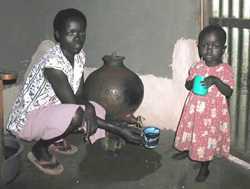World Water Day
Overview
 The United Nations (UN) designated March 22 of each year as World Water Day, with the overall objective to draw attention to conservation and development of water resources, through advocacy, publications, and the organization of conferences focusing on each year’s unique theme.
The United Nations (UN) designated March 22 of each year as World Water Day, with the overall objective to draw attention to conservation and development of water resources, through advocacy, publications, and the organization of conferences focusing on each year’s unique theme.
Official Website
Dates of Celebration and Additional Resources
2016
March 22, 2016
- MMWR Announcement: World Water Day 2016
- CDC Public Health Matters blog: Zika, Mosquitoes, and Standing Water
CDC Features: World Water Day 2016
Each year on March 22, World Water Day attracts international attention to the conservation and development of freshwater resources.
Water is a finite resource that is fundamental to human health and well-being. From food and energy security to human and environmental health, water is also an essential part of sustainable development. Nearly half of workers around the world (1.5 billion people) have jobs in water-related industries 1. Many industries rely on water to perform jobs, such as fishing, agriculture, manufacturing, and food service. Societies and economies depend on the people who work to keep the water we drink safe.
Managed efficiently, water plays an important role in strengthening the resilience of social, economic, and environmental systems in the face of rapid and unpredictable changes, including changes in the earth's climate. Climate change impacts water quality and availability, the infrastructure that provides access to safe drinking water, and the spread of waterborne diseases.
The World Health Organization estimates that an additional 250,000 people will die per year between 2030 and 2050 as a result of climate change 2. Diarrheal diseases from contaminated water and lack of adequate sanitation and hygiene will be a major cause of these additional deaths 3.
Now is the time to address these challenges and to commit to the responsible management of water resources to ensure sustainable development in the present and for generations to come.
For more information on World Water Day and ideas on how to get involved, visit the United Nations' World Water Day website.
Story from the Field: Cholera in Kenya
The world is currently experiencing an El Niño event that is bringing heavy rain and flooding to East Africa, while southern Africa is experiencing a drought. In the past, El Niño events have been linked to cholera outbreaks in the Africa Great Lakes Region countries 4. A large cholera outbreak has been ongoing in Kenya since January 2015. Patients in this outbreak did not have adequate access to safe water and sanitation services and did not practice proper handwashing 5. Infrastructure needs to be developed in response to changes in climate that affect access to safe water and adequate sanitation and hygiene.
CDC's Global Water, Sanitation, and Hygiene (WASH) Expertise
Inadequate water, sanitation, and hygiene (WASH) conditions exist in a range of settings, from temporary refugee camps to entire neighborhoods in large cities.
Since 1990, the number of persons able to access improved drinking water sources and sanitation facilities* has increased by 2.3 billion and 1.9 billion respectively. Despite these gains, hundreds of millions still lack access to these essential resources, making them susceptible to life-threatening WASH-related diseases ranging from cholera to typhoid fever to hepatitis 6. CDC's global WASH work involves partnerships with other US government agencies, ministries of health, non-governmental organizations, UN agencies, private companies and various international agencies. Our program provides expertise and interventions aimed at saving lives and reducing illness by improving global access to healthy and safe water, adequate sanitation, and improved hygiene.
The WASH program works on long-term prevention and control measures for improving health, reducing poverty, and improving socioeconomic development as well as responding to global emergencies and outbreaks of life-threatening illnesses. These improvements reduce illness and death from WASH-related disease and help to promote improved overall health, poverty reduction, and socio-economic development.
For more information on CDC's Global WASH Program, visit the CDC at Work section of our Global WASH website.
*An improved water source is defined as water that is supplied through a household connection, public standpipe, borehole well, protected dug well, protected spring, or rainwater collection. Improved sanitation facilities usually ensure separation of human waste from human contact.
References
- UN. World Water Day. 2017
- WHO. Health in 2015: from MDGs to SDGs (Chapter 2). [PDF - 24 pages] 2015.
- WHO. Health in 2015: from MDGs to SDGs (Chapter 5). [PDF - 32 pages] 2015.
- Nkoko DB, Giraudoux P, Plisnier PD, Mutombo Tinda A, Piarroux M, Sudre B, Horion S, Muyembe Tamfum JJ, Ilunga BK, and Piarroux R. Dynamics of Cholera Outbreaks in Great Lakes Region of Africa, 1978–2008. Emerg Infect Dis. 2011;17(11):2026-34.
- Githuka G, Rotich J, Kigen H, Catherine K, Waweru B, Boru W, Galgalo T, Githuku J, Obonyo M, Curran K, Narra R, Crow SJ, O'Reilly CE, Macharia D, Montgomery J, Neatherlin J, De Cock KM, Lowther S, Gura Z, Langat D, Njeru I, Kioko J, Muraguri N. Notes from the Field: Ongoing Cholera Outbreak – Kenya, 2014-2016. Morb Mortal Wkly Rep. 2016;65(3):68–9.
- UNICEF and WHO. Progress on drinking water and sanitation: 2014 update. 2014.
2015
2014
March 22, 2014
2013
March 22, 2013
2012
March 22, 2012
2011
March 22, 2011
2010
March 22, 2010
2009
March 22, 2009
2008
2008
March 22, 2008
- Page last reviewed: February 22, 2017
- Page last updated: February 22, 2017
- Content source:


 ShareCompartir
ShareCompartir